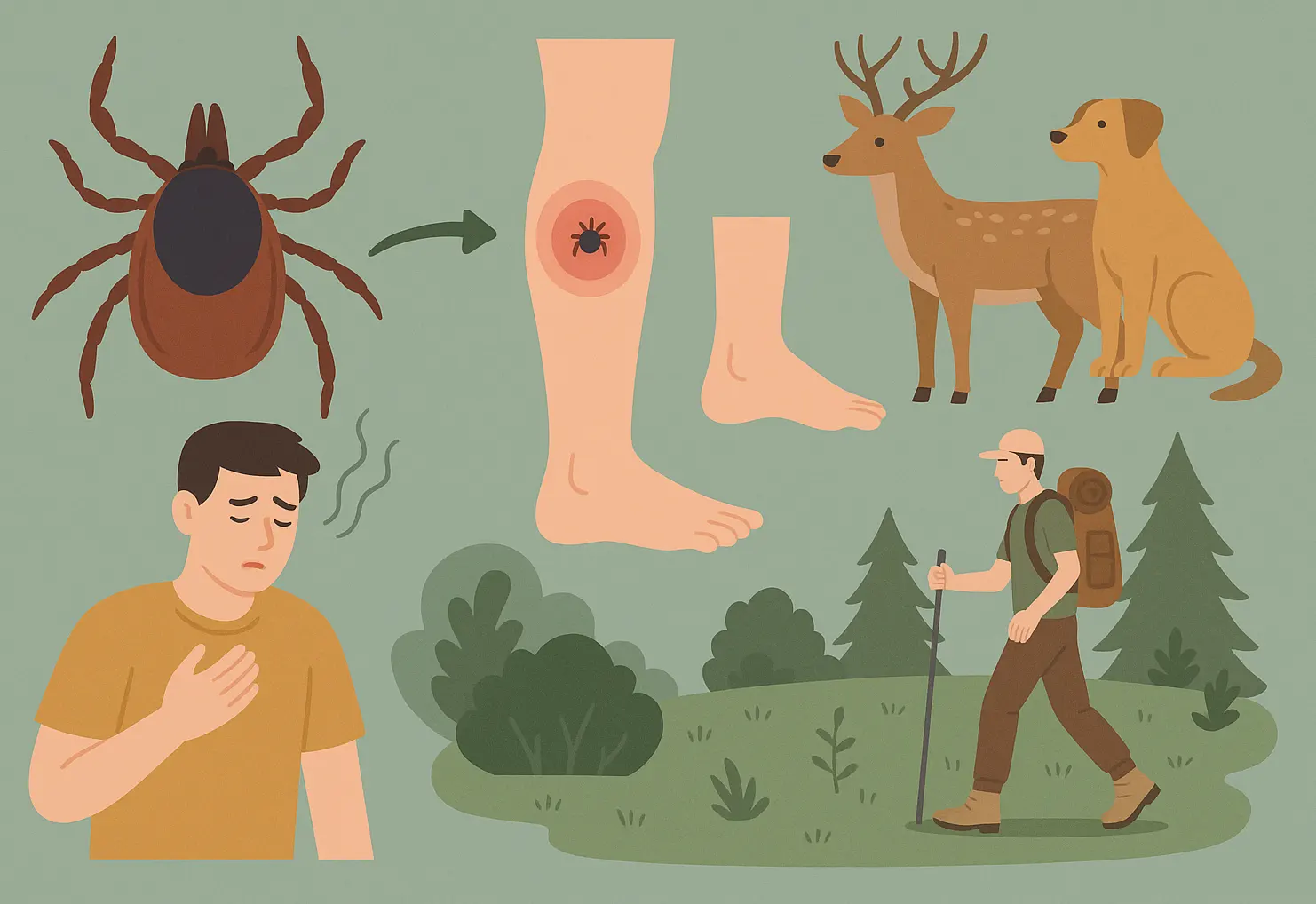
What Are Ticks and Why Are They a Concern?
Ticks are small, blood-feeding arachnids commonly found in wooded or grassy areas. Unlike insects, they belong to the arachnid family, which includes spiders and scorpions, and have eight legs as adults. Ticks latch onto the skin of humans and animals to feed on blood, often remaining attached for several days if not removed. While many tick bites are harmless, some ticks can transmit serious diseases, such as Lyme disease, Rocky Mountain spotted fever, ehrlichiosis, and tularemia. The risk of infection increases the longer a tick remains attached, making prompt and proper removal essential to minimize health risks.
How to Identify a Tick Bite
A tick bite typically appears as a small red bump on the skin, often with the tick still attached, as ticks embed their heads to feed. This distinguishes them from other insect bites, like mosquito bites, where the insect typically bites and leaves. The bite may be painless, and you might not notice it immediately due to the tick’s anesthetic saliva. In some cases, a rash may develop, particularly if the tick carries a disease. For example, Lyme disease can cause a distinctive bull’s-eye rash (erythema migrans) that appears 3 to 30 days after the bite and may grow up to 12 inches wide. Check areas like armpits, groin, behind the knees, or under hair, as ticks prefer warm, hidden spots.
Step-by-Step Guide to Removing a Tick
- Gather Tools: Prepare fine-tipped tweezers, rubbing alcohol, soap, and water. Fine-tipped tweezers are ideal for grasping small ticks without tearing them.
- Remove the Tick: Grasp the tick as close to the skin’s surface as possible with the tweezers. Pull upward with steady, even pressure. Avoid twisting or jerking, as this can cause the tick’s mouthparts to break off and remain in the skin.
- Clean Up: After removal, clean the bite area and your hands thoroughly with rubbing alcohol or soap and water to prevent infection.
- Dispose: Place the tick in a sealed bag or container, wrap it tightly in tape, submerge it in alcohol, or flush it down the toilet. Do not crush the tick with your fingers, as this could release potentially infected fluids.
Note: Avoid myths like using heat, nail polish, or petroleum jelly to remove ticks. These methods can cause the tick to release more saliva, potentially increasing the risk of disease transmission.
What to Do If a Tick Is Embedded
If the tick’s head or mouthparts remain in the skin after removal, don’t panic. These parts cannot transmit diseases on their own and will typically be expelled by the body over time, similar to a splinter. You can try to remove them gently with clean, fine-tipped tweezers sterilized with alcohol. If they cannot be easily removed, leave them alone and let the skin heal naturally. Clean the area thoroughly with soap and water or rubbing alcohol, and monitor for signs of infection, such as increased redness, swelling, or pus. If these symptoms appear, consult a healthcare provider promptly.
Symptoms and Treatment of Tick Bites
Immediately after a tick bite, you may notice a small red bump, mild itching, or irritation at the site, which typically resolves within a few days. However, it’s critical to monitor for symptoms of tick-borne diseases in the weeks following the bite. Common symptoms include:
- Fever or chills
- Headache
- Fatigue
- Muscle or joint aches
- Swollen lymph nodes
- A rash, such as the bull’s-eye rash associated with Lyme disease or small reddish spots (petechiae) seen in Rocky Mountain spotted fever
If any of these symptoms develop within a few weeks, seek medical attention immediately. Early diagnosis and treatment are crucial to prevent complications. In areas where Lyme disease is common, doctors may prescribe a single dose of doxycycline within 72 hours of tick removal for high-risk bites (e.g., from an Ixodes tick attached for 36 hours or more in an endemic area). For other tick-borne illnesses, treatment depends on the specific diagnosis, often involving antibiotics. Always consult a healthcare provider for personalized advice.
Preventing Tick Bites
- Wear Protective Clothing: Wear long-sleeved shirts, long pants, and high boots in tick-prone areas. Tuck shirts into pants and pants into socks to cover skin gaps. Light-colored clothing helps you spot ticks more easily.
- Use Repellents: Apply EPA-registered insect repellents containing DEET, picaridin, or Oil of Lemon Eucalyptus to exposed skin. Treat clothing and gear with 0.5% permethrin, which kills ticks on contact and remains effective through several washings.
- Avoid Tick Habitats: Stay in the center of trails to avoid brushing against tall grass, shrubs, or leaf litter where ticks thrive. Ticks cannot jump or fly but climb onto hosts from low vegetation.
- Check for Ticks: After outdoor activities, thoroughly check your body, especially in areas like armpits, groin, behind the knees, and under hair. Check pets and children, as ticks can hitch a ride into your home.
- Shower and Wash Clothes: Shower within two hours of coming indoors to wash off unattached ticks. Tumble dry clothes on high heat for 10 minutes (or longer if damp) to kill any ticks on clothing.
- Maintain Your Yard: Keep grass mowed, remove leaf litter, and create a barrier of wood chips or gravel between your lawn and wooded areas to reduce tick habitats.
Closing Advice: Protect Yourself from Future Tick Encounters
Ticks can pose a health risk, but with vigilance and the right precautions, you can significantly reduce your chances of being bitten. Always check yourself, your family, and your pets for ticks after spending time in wooded or grassy areas, especially during warmer months when ticks are most active. If you experience symptoms like fever, rash, or fatigue after a tick bite, don’t hesitate to seek medical advice. By staying informed and proactive, you can enjoy the outdoors safely. Share your tips and experiences in the comments below to help others stay tick-free!